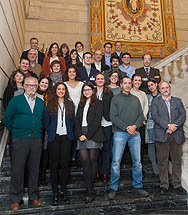The sustainability of Roman cities, a discussion
The meeting, held on November 10 and 11, brought together around thirty researchers

The School of Philosophy y Letras and the UNED of Pamplona hosted on November 10 and 11, the colloquium "De municipia Latina a oppida labentia: sobre la sostenibilidad del transcript municipal latino en la Hispania Romana (siglos II-III d. C.)", a scientific meeting possible thanks to the partnership between the University of Navarra, the UNED of Pamplona and the Caja Navarra Foundation, which has financed the work.
This meeting had for goal to unravel which material and juridical indicators portray the decline of many small Hispanic cities from the reign of framework Aureliusat the end of the second century AD. A good issue of students from the Degree in History at the University of Navarra and also from the programs of study in Geography and History at the National University of Education a Distancia participated and interacted with speakers from France, the United Kingdom and Spain.
From Spain, researchers from the Universities of Zaragoza, Cordoba, and committee Superior de Investigaciones Científicas came to Pamplona; and from Europe from Oxford, the French CNRS and the Université de La Rochelle.
In terms of specializations, the sessions brought together archaeologists, Romanists, epigraphers, philologists and experts on issues related to the landscape and the impact of Roman cities on it.
During the sessions -which also marked the start of a project of research financed by the Ministry of Economics and Competitiveness and directed by Prof. Javier Andreu, from the School of Philosophy y Letras- the need to draw up a list of possible signs of crisis that could be applicable to different models of Roman cities was underlined, always bearing in mind that there was no global crisis but that, indeed, there are signs of transformation, and of clear difficulty in many centers at the end of the High Empire. The incidence of plague epidemics, an unsustainable exploitation of the territory from the environmental point of view, the oversizing of the municipal offices and infrastructures extended in the Hispanic provinces by Augustus and the Flavians and some problems of political or institutional character, could be the reasons that explain why many cities, once monumental and tremendously scenic, ended up becoming fields of ruins from the end of the 2nd century and, definitively, during the 3rd century. The conference proceedings of the work will soon see the light thanks to a partnership between the University of Navarra, the UNED of Pamplona and the project of research of Los Bañales.
On Saturday morning, the congress participants visited the Roman city of Los Bañales, where numerous students from the University of Navarra have been excavating since 2012, and whose monumental forum -the public place of the city- has given remarkable material samples of this institutional crisis that turned the Hispano-Roman municipality, on many occasions, into an illusionary wish but a difficult reality.


